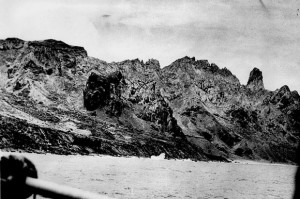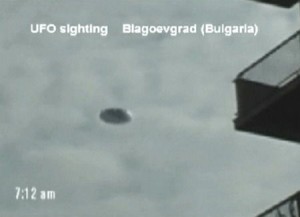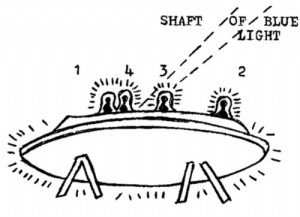Warning: strlen() expects parameter 1 to be string, array given in /home2/orbman69/public_html/wp-includes/functions.php on line 262
(Last Updated On: )
THINK ABOUTIT SIGHTINGS REPORT
Date: January 16, 1958
Sighting Time: 12:15 P.M.
Day/Night: Daytime
Location: Trindade Island, Brazil
Urban or Rural: Island
Hynek Classification: DD (Daylight Disc) Metallic or whitish object was seen in the day.
Duration:
No. of Object(s): Single
Size of Object(s):
Distance to Object(s):
Shape of Object(s): Disc
Color of Object(s): gray, metallic
Number of Witnesses: Multiple
Source: STUDIOVNI/ Jerome Clark (CUFOS)
Summary: Trindade, a small rocky island in the middle of the South Atlantic Ocean 600 miles off the coast of Bahia, Brazil, was the site of one of the most impressive photographic cases in UFO history.
Full Report

By Jerry Clark (Center for UFO Studies)
Trindade, a small rocky island in the middle of the South Atlantic Ocean 600 miles off the coast of Bahia, Brazil, was the site of one of the most impressive photographic cases in UFO history.
In October 1957 the Brazilian Navy set up a small scientific base on the unoccupied island, where oceanographic and meteorological research would be conducted in connection with the International Geophysical Year. Starting early the next month, instrument-bearing weather balloons were launched daily. They were designed to explode in the upper atmosphere, releasing the instrument packages which would parachute to earth to be retrieved by the researchers. By the end of the month base personnel were reporting silvery UFOs which seemed to be monitoring the balloons’ movements.
On January 1,1958, at 7:50 A.M., the passage of a bright point of light, like a mirror reflecting sunlight, was observed by the entire garrison. The next evening a round object with an orange glow circled the Navy tow ship Triunfo traveling off the Bahian coast 400 miles from Trindade. As the crew watched, the UFO executed sudden right-angle turns and at other times hovered near the ship. The sighting lasted for 10 minutes.
The most fantastic event occurred on the sixth. The base’s chief officer, Cmdr. Carlos A. Bacellar, had just overseen the launching of a weather balloon into a morning sky clear of everything but a single large cumulus cloud at 14,000 feet. Inside the radio cabin Bacellar listened to the signals the balloon emitted as it ascended. Suddenly those signals inexplicably diminished, then went dead.
When Bacellar went outside to investigate, he saw nothing out of the ordinary, at least at first. The balloon was ascending normally—until it came directly below the cloud, at which point it seemed to be sucked abruptly upward. For the next 10 minutes it remained out of sight and inside the cloud. Finally, when it reappeared, it was above the cloud and devoid of the instrument package.
Soon a silvery object emerged from behind the cloud. As it moved slowly from the southwest to the east, a technician gazing through a theodolite spotted it and alerted the commander, who viewed it briefly through binoculars, then through a sextant. Crescent-shaped and bright white in color, the object reversed course at one point and remained in sight for some time before it entered a cloud bank (Fontes, 1960).
The photographs
Later [16JAN58], at 12:15 P.M., as the Almirante Saldanha sat anchored off the south coast of Trindade and prepared for a return trip to Rio de Janeiro, 48 crew members and passengers spotted an object approaching the island. Among the witnesses was Almiro Barauna, a civilian who had been brought along because of his skill in underwater photography. Barauna gave this account to João Martins of the magazine 0 Cruzeiro:
I had my Rolleiflex 2.8-model E, which was kept inside an aluminum box for protection against the corrosive effects of water and salt. I had left my Leica with a telephoto lens in my cabin a few minutes before. The deck was full of sailors and officers. Suddenly Mr. Amilar Vieira and [retired Air Force] Capt. [José Teobaldo] Viegas called to me, pointing to a certain spot in the sky and yelling about a bright object which was approaching the island.
At this same moment, when I was still trying to see what it was, Lt. Homero [Ribeiro] — the ship’s dentist—came from the bow toward us, running, pointing to the sky and also yelling about an object he was sighting. He was so disturbed and excited that he almost fell down after colliding with a cable. Then I was finally able to locate the object, by the flash it emitted. It was already close to the island.
It glittered at certain moments, perhaps reflecting the sunlight, perhaps changing its own light — I don’t know. It was coming over the sea, moving toward the point called the Galo Crest. I had lost 30 seconds looking for the object, but the camera was already in my hands, ready, when I sighted it clearly silhouetted against the clouds. I shot two photos before it disappeared behind Desejado Peak. My camera was set at speed 125, with the aperture at f/8, and this was the cause of an overexposure error, as I discovered later.
The object remained out of sight for a few seconds— behind the peak— reappearing bigger in size and flying in the opposite direction, but lower and closer than before, and moving at a higher speed. I shot the third photo. The fourth and fifth ones were lost, not only because of the speed the saucer was moving, but also for another reason: in the confusion produced as a result of the sighting, I was being pulled and pushed by other persons also trying to spot the object and, as a consequence, photographed the sea and the island only—not the object. It was moving again toward the sea, in the direction from which it had come, and it appeared to stop in mid-air for a brief time. At that moment I shot my last photo (the last on the film). After about 10 seconds, the object continued to increase its distance from the ship, gradually diminishing in size and finally disappearing into the horizon [ibid.].
The object was gray, metallic, and solid-looking, though surrounded by a greenish haze or mist. With a ring running through its midsection, it resembled a flattened version of the planet Saturn.
Badly shaken by the experience, Barauna removed the film from the camera almost immediately but delayed processing it for an hour. Finally he and Capt. Viegas entered the ship’s darkroom together, while Cmdr. Bacellar (who had not been on deck when the sighting occurred) waited outside the door. Ten minutes later Barauna showed the wet negatives to Bacellar (there was no photographic paper available) and said that it looked as if the UFO’s image had not been picked up. The commander examined the negatives carefully and spotted the image. Subsequently, the other witnesses stated that the object in the photographs was the one they observed (“New Evidence,” 1965).
Aftermath
Barauna took the negatives with him to Rio and processed them in his own laboratory. Shortly afterwards Bacellar showed up at Barauna’s home to look at the developed photographs, which he then took to the Navy Ministry. Two days later he returned them, and shortly thereafter Barauna was summoned to naval headquarters, where high-ranking officers grilled him. The Ministry sent his negatives to the Cruzeiro do Sul Aero Photogrammetry Service for analysis. They were declared genuine. In short order Brazil’s President, Juscelino Kubitschek, ordered them released to the press.
In the days ahead some of the witnesses gave interviews to newspapers. On the twenty-second Cmdr. Paulo Moreira da Silva of the Brazilian Navy’s Hydrography and Navigation Service stated that the “object was not a meteorological balloon, for the one we had launched that day was released at 9 A.M., two [sic] hours before the appearance of the object in the sky… . Also it was not a guided missile from the United States because the island of Trindade is off the route of those rockets.”
Olavo T. Fontes, a well-connected Rio physician who represented the Tucson-based Aerial Phenomena Research Organization (A.P.R.O.), learned of the incident from naval informants on February 4. On the evening of the fourteenth, at the Navy Ministry, he was shown five photographs. He did not know then that the fifth had been taken earlier than the first four (Barauna’s photographs), and to this day little is known about this picture. Fontes believed it was taken by a Navy sergeant in late December at Desejado Peak on the island (Lorenzen, 1962).
A naval source later told Fontes that the day before Barauna took his pictures, the Almirante Saldanha’s radar had tracked an unknown object. At 2:30 A.M. on the sixteenth, less than 10 hours before the Barauna sighting, Ezio Azevedo Fundao, chief of surgery at a Rio hospital, and members of his family saw a Saturn-shaped UFO off the coast of Brazil, in the direction of Trindade. At approximately the same time the same or an identical object was observed from the deck of the Tridente, a Navy tow ship.
On February 23 Paulo M. Campos, a reporter for Diario Carioca, citing an unnamed but “best possible” source, wrote that “more than the sighting of the flying saucer itself, what really made a deep impression on the Navy was the report that instruments like radio transmitters, and apparatus with magnetic needles, ceased operating while the flying object remained in the island’s proximity. The Navy decided to
consider this a top-secret fact.” When he checked with his own sources, Fontes could get neither confirmation nor denial of this alleged aspect of the event. (In a 1983 interview Barauna recalled that just prior to the UFO’s appearance all of the electrical power on the ship had failed [Smith, 1983].)
After Brazil’s House of Representatives demanded further information from the Navy, it was given a secret report on the official investigation. The document was leaked in October 1964 to Coral Lorenzen, director of APRO. After reviewing the various sightings and the January 16 photographs, its author, Corvette-Capt. Jose Geraldo Brandao, concluded that the “existence of personal reports and of photographic evidence, of certain value considering the circumstance involved [absence of evidence of tampering, the presence of other witnesses], permit the admission that there are indications of the existence of unidentified aerial objects.” He also noted the “strong emotional upset . . . in all persons who sighted the object, including the photographer, civilians, and members of the ship’s crew” (“New Evidence,” op. cit.).
A hoax?
On November 27, 1959, Donald H. Menzel, a Harvard University astronomer and UFO debunker, wrote Richard Hall of the National Investigations Committee on Aerial Phenomena to report his “tentative conclusion” concerning the object in the Trindade photograph:
I have in my possession one well-authenticated case of a saturn-like object, whose nature is known and clearly distinguishable in this particular instance. A plane, flying in a humid but apparently super-cooled atmosphere, became completely enveloped in fog, so about all one could see was a division where the stream lines were flowing up and down respectively over and under the wings. The cabin made a saturn-like spot in the center, and the wings closely resembled the appearance of the Brazilian photographs.
The Trindade object’s speed and sprightly maneuvers were explainable, Menzel claimed, as an illusion created by the reflection of sunlight on the plane.
But four years later, in The World of Flying Saucers, Menzel publicly declared the case a hoax, charging that Barauna had faked the photographs via double exposure in collusion with an associate (Menzel and Boyd, 1963). He wrote, without mentioning newspaper articles and official reports to the contrary, that when reporters had a “chance to interview the officers and crewmen who allegedly had observed the Trindade saucer and could support Barauna’s story… [n]one of them had actually seen the object.” In fact, in 1959 Hall had provided Menzel with a translation of a March 8, 1958, O Cruzeiro article which names several of the witnesses (Hall, 1959).
Menzel reprints a Brazilian Navy press release, but when the original and Menzel’s version are compared, some significant discrepancies become apparent. In the latter three words are added and six left out.
The original reads: “Evidently, this Ministry cannot make any statement about the object sighted over the island of Trindade, for the photographs do not constitute enough evidence for such a purpose.” Menzel renders it thus: “Clearly, this Ministry cannot make any statement about the reality of the object, for the photos do not constitute enough evidence for such a purpose.” Whereas the first statement acknowledges an object and a sighting, the second implies that their reality is open to question — hardly the Brazilian Navy’s intention.
Menzel’s attack continues in his next book, The UFO Enigma, wherein — though citing no source — he outlines the “extremely simple” method that he claimed was used to fake the photographs. “In the privacy of his home,” Menzel writes, “the photographer had snapped a series of pictures of a model UFO against a black background. He then reloaded the camera with the same film and took pictures of the scenery in the ordinary fashion. When the film was developed, there was the saucer hanging in the sky.” Menzel seems to have woven this story out of whole cloth. He also repeats the unfounded allegation that “no one else, except a friend (and presumed accomplice), had seen the disk flying overhead” (Menzel and Taves, 1977).
Though the U.S. Navy, which had expressed interest in the case at the time of its occurrence (Fontes, op. cit.), refused public comment, in a 1963 letter Maj. Carl R. Hart of the U.S. Air Force’s Project Blue Book quoted from an Office of Naval Intelligence report: “This gentleman [Barauna] has a long history of photographic trick shots. . . . [He prepared a purposely humorous article, published in a magazine, entitled ‘A Flying Saucer Hunted Me at Home’, using trick photography” (Hart, 1963). It should be noted that the article was a debunking piece intended to show how a much-publicized 1952 Brazilian flying-saucer photograph was created (Smith, op. cit.).
In 1978 an Arizona-based group, Ground Saucer Watch (GSW), which specialized in analysis of purported UFO photographs (and which had rejected most as phony), subjected good-quality prints to a computer-processing technique, focusing on edge enhancement, color-contouring, picture-cell distortion, and digitizing. GSW’s specialists came to these conclusions:
The UFO image is over 50 feet in diameter. The UFO image in each case reveals a vast distance from the photographer/camera. The photographs show no signs of hoax (i.e., a hand-thrown or suspended model). The UFO image is reflecting light and passed all computer tests for an image with substance. The image represents no known type of aircraft or experimental balloon. Digital densitometry reveals a metallic reflection. We are of the unanimous opinion that the Brazilian photos are authentic and represent an extraordinary flying object of unknown origin [Hewes, 1979].
Given the number of witnesses, the results of photo analysis both military and civilian (Hopf, 1960), and the need for debunkers to reinvent the incident to “explain” it, it seems most unlikely that the Trindade photographs were hoaxed.
Sources:
Fontes, Olavo T. “The UAO Sightings at the Island of Trindade.” The A.P.R.O. Bulletin Pt. I (January 1960): 5-9; Pt. II (March 1960): 5-8; Pt. III (May 1960): 4-8.
Hall, Richard H. Letter to Donald H. Menzel (November 2,1959). Hall, Richard H., ed. The UFO Evidence. Washington, DC: National Investigations Committee on Aerial Phenomena, 1964.
Hart, Carl R. Letter to Richard H. Hall (January 24, 1963).
Hewes, Hayden. “The Mystery Disk over Trindade Island.” UFO Report 7,1 (February 1979): 18-19,58.
Hopf, John T. “Exclusive IGY Photo Analysis.” The A.P.R.0. Bulletin (May 1960): 1,4.
“IGY Team Snaps UFO.” The A.P.R.O. Bulletin (March 1958): 1,6.
Lorenzen, Coral E. The Great Flying Saucer Hoax: The UFO Facts and Their Interpretation. New York: William-Frederick Press, 1962. Revised edition as Flying Saucers: The Startling Evidence of the Invasion from Outer Space. New York: New American Library, 1966.
“Brazilian Official Report on the Trindade UFO.” Fate 18,3 (March 1965): 38-48.
Menzel, Donald H. Letter to Richard H. Hall (November 27, 1959). Menzel, Donald H., and Lyle G. Boyd. The World of Flying Saucers:A Scientific Examination of a Major Myth of the Space Age.Garden City, NY: Doubleday and Company, 1963.
Menzel, Donald H., and Ernest H. Taves. The UFO Enigma: The Definitive Explanation of the UFO Phenomenon. Garden City, NY: Doubleday and Company, 1977.
“New Evidence on IGY Photos.” The A.P.R..0. Bulletin (January 1965): 1,3-8.
Smith, Willy. “Trindade Revisited.” International UFO Reporter 8,4 (July/August 1983): 3-5,14.
“UFOs in Latin America.” In Hilary Evans with John Spencer, eds. UFOs 1947-1987: The 40-Year Search for an Explanation, 97-113. London: Fortean Tomes, 1987.
“UFO Photo Certified by Brazilian Navy Labeled a Hoax by USAF.” The UF0 Investigator 1,10 (July/August 1960): 3.
* By permission of the author. Clark, J. “Trindade Island Photographs.” The UFO Encyclopedia: The phenomenon from the beginning (2nd ed., Vol. 2, pp. 898-903). Detroit, MI: Omnigraphics, Inc. 1998






Related Reports
Warning: strlen() expects parameter 1 to be string, array given in /home2/orbman69/public_html/wp-includes/functions.php on line 262
3 min read
1947: 7 ft Aliens spotted in Brazil
Warning: strlen() expects parameter 1 to be string, array given in /home2/orbman69/public_html/wp-includes/functions.php on line 262
5 min read
1952: Barra da Tijuca, Brazil Photos
Warning: strlen() expects parameter 1 to be string, array given in /home2/orbman69/public_html/wp-includes/functions.php on line 262
1 min read
1952: Contact in Angatuba Mountains, Parana, Brazil